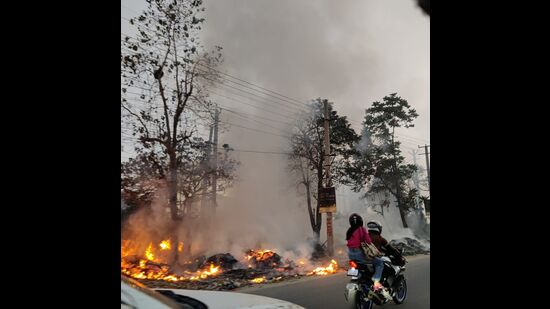Rampant waste burning in Sec 50 poses toxic threat for Gurugram residents
Fires have raged through the winter months, despite GRAP restrictions. The repeated combustion of dry leaves, garden clippings and dumped municipal waste continues, suffocating the city even after the winter season has passed
Gurugram: A cloud of smoke laced with the stench of burnt plastic and metal frequently rises over Sector 50, shrouding the neighbouring residential areas of Nirvana Country, Mayfield Gardens and Close Apartments in a toxic haze. This isn’t an isolated incident— it’s a recurring crisis. Residents allege that fires erupt every few days in the vicinity, triggered by the unchecked burning of horticulture, municipal and scrap waste. Despite more than a decade of documentation, petitions, citizen activism and official orders, including repeated imposition of Section 144, the problem persists.

The health impact of this “silent killer” is palpable. “We take 24,000 breaths a day. If they’re filled with pollutants from burning e-waste, plastic, biomass—it’s pure poison,” said Ruchika Sethi Takkar, a long-time resident and civic volunteer who has spent 11 years chasing waste fires. “The system has failed us. Toxic air is now a reality.”
The fires have been systematically documented, October 26, November 18, February 27, March 13, and again on March 24—many of these during the pollution-sensitive GRAP (Graded Response Action Plan) enforcement period. “It’s as if GRAP exists only on paper,” said another resident. “Every four days, the smell of burnt metal and plastic chokes us. These are not accidental fires—they are planned.”
Sector 29, too, is battling the same fate.
Other hotspots include Sectors 80 to 85, flanking Navada village, where resident and long-time citizen volunteer Vikas Yadav has spent nine years documenting repeated waste fires. “Diesel filters, scrap metal, foam, trimmings—they burn it all. I have seen thick green and blue smoke engulf our village. Cancer cases are rising, and I have escalated the issue repeatedly, but it’s getting worse.”
Sector 65 is yet another danger zone. Fires have raged through the winter months, despite GRAP restrictions. The repeated combustion of dry leaves, garden clippings and dumped municipal waste continues, suffocating the city even after the winter season has passed.
Adding to the evidence, the Air Quality Monitoring Station at Gurugram University in Sector 51—adjacent to several of these fire-prone areas—frequently records spikes in PM2.5 levels that are attributed by locals to this illegal burning.
The statistics are alarming. Last March, national dailies reported 29 days of fires in a single month, most of them attributed to waste burning. Yet, enforcement remains weak. The problem, say activists, is structural. “We have submitted petitions— with over 25,000 signatures—to the deputy commissioner in 2016 and again to the Municipal Corporation of Gurugram commissioner in 2017. Section 144 was imposed twice. Yet, the situation remains unchanged,” said Sethi, who launched the ‘Why Waste Your Waste’ campaign in 2014.
“Despite bans, fires are lit systematically and without fear,” said Dr Neetu Jain, a pulmonologist and resident of Close Apartments. “My young son has chronic coughs, requiring inhaled steroids. The outdoor air is harming children and seniors alike. Even post-winter, air quality remains poor. These everyday fires are manageable but deeply neglected.”
Bharat Sharma, a resident of Sector 104, shared a similar concern: “We’ve been reporting garbage fires on Dwarka Expressway since 2018. Workers sweep the roads and set the waste on fire. We try to give our children a better future, but we can’t even give them clean air.”
In response to the growing outcry, Vijay Choudhary, regional officer (South Gurugram) of the Haryana State Pollution Control Board (HSPCB), told Hindustan Times, “We are deeply concerned about the recurring waste fires. I will deploy a team to inspect the affected hotspots immediately. Strict action will be taken against those responsible. We will coordinate with MCG and the police to ensure enforcement.”
The bigger picture points to a systemic lack of capacity and infrastructure. With Gurugram’s waste generation growing exponentially, and in the absence of decentralised processing or effective disposal systems, burning becomes the easiest—and deadliest shortcut.






